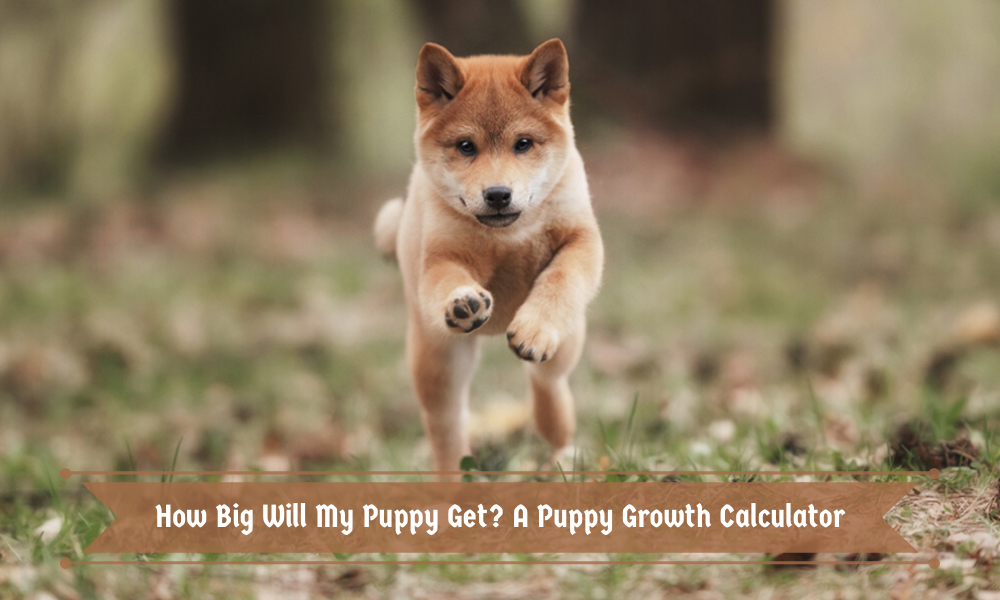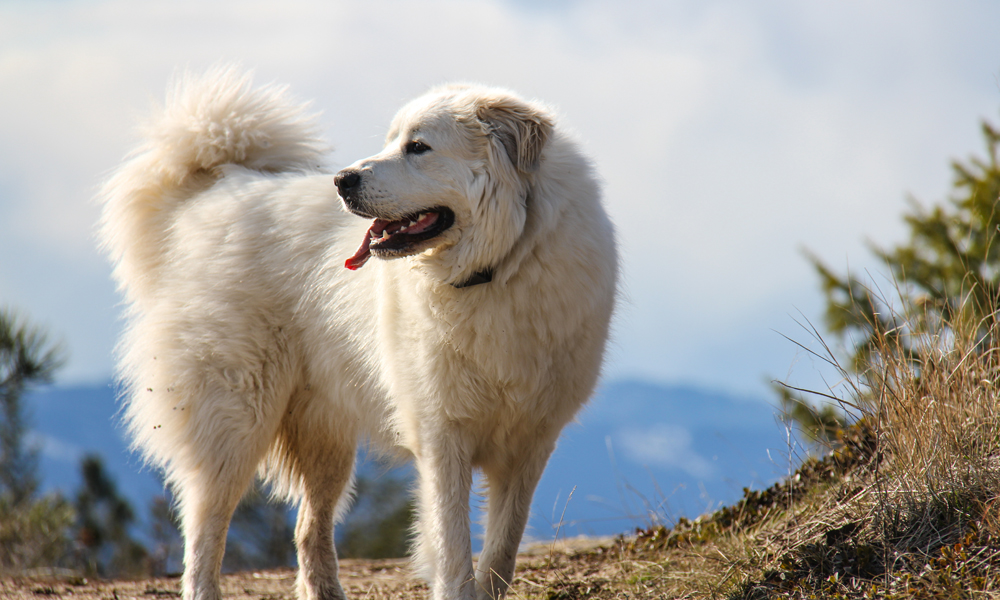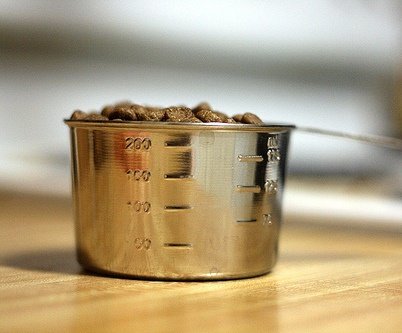
How big will my puppy be? If you’ve adopted your dog at a young age, then it’s guaranteed that you’ve asked a vet, breeder, or both this question. While it’s good to know for curiosity’s sake, it’s also extremely helpful for planning ahead. You’ll need to know how big of a dog crate to get, the size of their collar, as well as if you have the room for the eventual size your full-grown pup will grow into. Of course, if you have a purebred dog, you’ll be able to easily obtain an estimate on the average size of that fully-grown breed. However, there are plenty of cases where the dog doesn’t grow anywhere near that size for one reason or another, or they grow well beyond the average.
So, how can you get a good idea of how big your puppy will get? We’re going to look at factors that influence your puppy’s growth, so you can know how big your puppy should get if they grow to their full potential. We’ve also supplied you with some crafty calculations, so you can obtain measurements that are personalized to your particular pup!
Contents
- When Will My Puppy Stop Growing?
- Other Factors That Influence Puppy Size
- How Diet Affects Puppy Growth
- How Breed Affects Puppy Growth
- Weight Estimate by Size and Breed
- Unsure of Your Dog’s Breed?
- Is Paw Size A Good Predictor?
- How Else Can I Calculate Adult Size?
- Can I Predict My Dog’s Height?
- Can You Ever Know for Sure How Big Your Puppy Will Get?
When Will My Puppy Stop Growing?

Did you know that the larger the breed, the longer it takes for them to fully grow? This is clearly due to the fact that a giant breed like the Great Dane has way more room to grow then the tiny Chihuahua, increasing their birth weight by approximately 100 times by the time they’re a fully grown adult. Therefore, a toy dog that only grows by about 15 times their birth weight will likely reach maturity in a matter of six months, while a large breed will continue growing for 18 to 24 months.
Other Factors That Influence Puppy Size
While a puppy’s breed will largely be responsible for their adult size, there are other factors at play that influence their growth. These include:
- Gender: It’s a general rule that male dogs tend to be bigger than females, in terms of both height and weight, with a female reaching maturity faster. The difference is usually only slight and is more pronounced in larger breeds, as opposed to a small breed or toy breed. Puppies from the same litter can grow up to be vastly different in size as well, whether male or female, and can grow and develop at different rates.
- Age at desexing: Did you know that having your pup fixed too early can prevent them from filling out to their full potential? Early altering can slow down and reduce muscle development, which will again be noticed more in larger breed dogs. However, early neutering can actually make your dog taller, as this process cancels out chemicals in the body that tell the bones to stop growing. So, while your dog will be taller, they may not reach their full potential muscle-wise and can decrease the appetite.
How Diet Affects Puppy Growth
There’s a reason why rescues, breeders and veterinarians stress the importance of feeding your puppy a good and well-balanced diet. There is a large correlation between your puppy’s eventual size and their diet, which doesn’t just include their weight. Any puppy or dog weight estimate is based on the assumption that the dog is well fed. Not only will underfeeding or feeding food that doesn’t contain the proper nutrients have a negative effect on your puppy’s weight, but it will also slow their development.

On the other hand, overfeeding your dog can cause just as many health risks as underfeeding, with obesity in dogs becoming a more common problem. While this issue is largely caused by overfeeding, it’s also caused by feeding the wrong food, opting for “filler” foods over brands that are well-balanced and nutritious.
Keep in mind that your puppy is bound to go through some awkward stages, as we all do when we’re growing up! Puppies may appear more plump and round and then start to look a little on the skinny side as they begin to grow and develop. This is totally normal and food should not be altered according to either of these factors. It’s important to ask your veterinarian if your puppy is on the right track, as they will understand what is normal and what is not.
How Breed Affects Puppy Growth
While your dog’s breed will not give you a definite picture of their eventual size, it can be a great rough indicator. A puppy’s main growth stage will occur between birth and six months of age, but they will continue to put on muscle mass and height until they reach adult size. Your puppy’s breed and size will indicate how long it will take to reach the end of this main stage of development and when they will reach full maturity.
It’s important to note that toy and small breeds develop the fastest, due to the fact that they do not have anywhere near as much growing to do as larger breeds. This rapid growth period also gradually slows down once your puppy reaches about 65% of their adult height.
As a general rule, puppies of different sizes grow the fastest during the following periods:
- Toy and Small breeds – Birth to 11 weeks
- Medium breeds – Birth to 16 weeks
- Large breeds – Birth to 20 weeks
- Giant breeds – Birth to 25 weeks
Weight Estimate by Size and Breed
There are some general rules when it comes to estimating a puppy’s adult weight by their size and/or breed. Judging by their size, all dogs will approximately fit into one of the below categories, which will give a better estimate on how to calculate their weight when they reach full maturity.
Toy Breeds

Toy breeds such as the Chihuahua, Maltese, Pekinese and Pomeranian, grow the fastest out of any breed and will stop growing when they reach eight to nine months. If you reference the chart above, you’ll know that they grow the most from the time they’re a newborn, until 11 weeks. Toy breeds gain anywhere from 5% to 10% of their body weight every day (1 to 5 oz per week), you can do the following calculation:
Take your puppy’s 6-week weight (if you don’t know it, you can ask the breeder or do a rough estimate yourself), and double it twice. Using this calculation, if a puppy weighs 3lbs at 6-weeks, their adult weight will be about 12 pounds (3×2=6, 6×2=12).
Small Breeds
Small breeds such as the Beagle, Dachshund, French Bulldog and Jack Russell Terrier reach their full growth potential between eight and twelve months, with the most growth occurring between 0 and 11 weeks. These small breeds gain roughly 5 to 8 ounces per week. You can use the same calculation as the Toy breed example above to calculate their eventual full-grown dog weight, by taking the puppy’s 6-week weight and doubling it twice.
Medium Breeds
Medium breeds such as the Border Collie, Cocker Spaniel and Bulldog, are similar to toy breeds in that from nine and twelve months of age, medium breeds can hit their adult weight. However, they grow the most rapidlywhen they are between 0 and 16 weeks old. In order to calculate the weight that your medium-sized breed will be,use their 14-week weight,double it and add the result to half of their 14-week weight. If your medium-sized puppy’s 14-week weight is 15 pounds, the calculation would be: 15×2=30, 30+7=37 pounds fully grown.
Large Breeds
Large breed dogs such as the Boxer, Bloodhound, Doberman Pinscher, German Shepherd and Golden Retriever take around twelve to eighteen months to reach their adult weight and height, with the majority of their growth occurring between 0-20 weeks. All you need to do to calculate an adult breed’s adult weight is to double their 6 month’s weight.
Giant Breeds

Giant breeds, including the Great Dane, Irish Wolfhound, and Mastiff, take the longest to finish growing, taking twelve to eighteen months to finish most of their growing, with their fastest growth rate occurring between 0 to 25 weeks. Giant breeds usually continue to fill out and gain muscle mass up to 3 years of age, which is when they will truly reach their adult size.
While you can double their weight at 6 months of age to find their adult weight, this likely won’t be as accurate as it could be. Another method is to divide their 20-week weight by their current age in weeks and multiply this figure by 52. For example, the calculation for a puppy who weighs 46 pounds at 20 weeks would be: 46÷20=2.3, 2.3×52=119.6 pounds.
Unsure of Your Dog’s Breed?
If you don’t know the breed of your puppy, you may not even know which of these categories they fall into, making it much harder to find their approximate adult size. In this case, these are dog DNA tests available online, that will determine your dog’s genetic makeup. You can also request the expert advice of your veterinarian, as well as the shelter where you adopted your furry friend from.
Is Paw Size A Good Predictor?
You’ve more than likely heard someone exclaim that their 8-week old puppy is going to be huge, judging by the size of their paws. While this may be true in some cases, some dogs just have naturally bigger or smaller paws for their breed, which may have little to do with how large they will get as a fully-grown dog. An English bulldog may have the paw size of a large dog, but that certainly doesn’t mean they’re going to be large in height (although, they will definitely be stocky!).
How Else Can I Calculate Adult Size?
We understand that it’s likely you’ve adopted your puppy late or didn’t obtain them from a breeder and you have no idea how much they weighed at six-weeks, or even six-months. So, how can you determine what their weight is going to be without this information?

There’s an alternative formula to reach an approximate size for your pup, without knowing their early puppy weight. Keep in mind, this will just be approximate and will be better suited to dogs that are small to medium sized, rather than large and giant breeds.
First, you’re going to need to take your pup’s weight in pounds and divide it by his age in weeks. You then multiply that number by 52, which is the number of weeks in a year. This should predict your dog’s approximate adult weight.
Can I Predict My Dog’s Height?
Fun fact, a dog actually reaches their full height before their full weight. At 4 months old, your dog will only have reached about 30% of their adult weight, but has achieved 60% of their adult height. This is why you’ll see puppies go through that perfectly normal awkward, lanky stage.
So, how do you predict your puppy’s adult height? There’s a calculation for that, too! Measure your pup’s height at 6 months of age, from the top of the shoulders to the floor, making sure he’s fully upright, with his legs vertical. Then, multiply this figure by 100, dividing the resulting figure by 75. This means, your puppy will have achieved 75% of their adult height by the time they’re 6 months old.
Can You Ever Know for Sure How Big Your Puppy Will Get?
The answer to this question is no. Even if you do everything absolutely right, your puppy might just be genetically smaller or bigger than the majority of their breed, or even their brothers and sisters. It’s important to account for the fact that your puppy may be a different size than the standard and there’s absolutely nothing wrong with that! While weight is certainly nice to know for planning ahead and making sure you have enough room in your home, ultimately, it’s of little importance. Enjoy watching your pup grow and do everything you can to help them reach their full potential.
I grew up in a household that was filled with animals. I believe that my fate as a dog-loving person was sealed in early childhood since my parents owned several dogs of varying sizes and breeds. There was no choice but to take care of and learn about dog habits and the best animal care practices — otherwise, I’d be clueless about how to go about the creatures I was surrounded by day and night.
As a life-long puppy lover, I know a thing or two about dogs and how to go about caring for them in the best way possible. Although I’m not a professionally trained dog behaviorist, trainer, or veterinarian, all of my knowledge and experience with canines comes from a place of love and a deep-rooted passion for dogs and animals in general.
Seeing as dogs kept me company throughout every stage of my life, I decided to follow a different path in my academic life and obtained a Bachelor’s and Master’s degrees in Marketing Management and Digital Advertising, which ultimately allowed me to combine my professional training and personal experience by creating the ultimate dog lover’s resource website! Along with my husband, Dave, I run MySweetPuppy for like-minded dog lovers who want to have a single, clear, and reliable information source about anything and everything related to dogs and their well-being.



